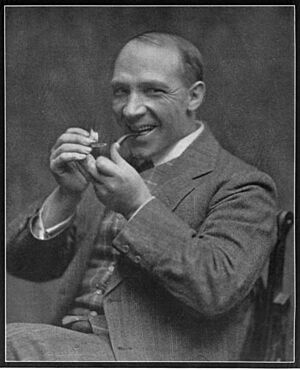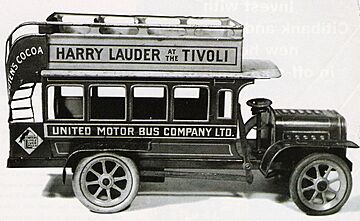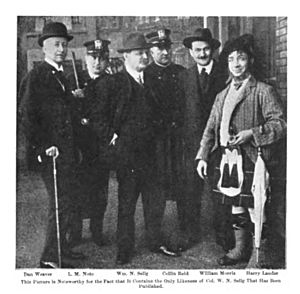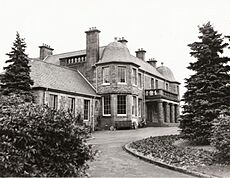Harry Lauder facts for kids
Sir Harry Lauder (born August 4, 1870 – died February 26, 1950) was a famous Scottish singer and comedian. He was very popular in both music hall and vaudeville shows, becoming a worldwide star.
Sir Winston Churchill, a famous British leader, called him "Scotland's greatest ever ambassador." He said Harry Lauder's songs and brave life helped Scotland and the British Empire a lot. Harry Lauder became well-known around the world for wearing a kilt and carrying a special walking stick called a cromach. People especially loved him in America. Some of his most famous songs include "Roamin' in the Gloamin'", "A Wee Deoch-an-Doris" (a small drink at the door), "The End of the Road," and his huge hit, "I Love a Lassie."
Harry Lauder understood life's ups and downs, which made him so popular. He often performed in full Scottish Highland dress, including a kilt, a sporran (a pouch), a tam o' shanter (a hat), and his twisted walking stick. He always sang Scottish-themed songs.
By 1911, Harry Lauder was the highest-paid performer in the world. He was also the first British artist to sell a million records. By 1928, he had sold two million! He helped raise a lot of money for the war effort during the First World War. For his efforts, he was made a knight in 1919. He mostly retired in the mid-1930s but came back briefly to entertain soldiers during the Second World War. He passed away in Scotland in 1950 after a long illness.
Contents
Early Life and First Performances
Harry Lauder was born on August 4, 1870, in Portobello, Edinburgh, Scotland. He was the oldest of seven children. His father, John Lauder, died when Harry was only 11 years old. This left his mother, Isabella, with very little money.
To help his family, Harry started working part-time at a flax mill when he was 11. He made his first public appearance singing at a concert in Arbroath when he was 13. He won first prize, which was a watch! In 1884, his family moved to Hamilton, South Lanarkshire. Harry found a job at a coal mine, where he worked for ten years.
Career in Mining
Harry Lauder was proud to have been a coal miner. He once shared a scary story about his time in the mines.
A Miner's Story
He was trapped underground for six long hours once, which felt like six years. Another time, a huge stone fell on his friend, burying him. Harry, with amazing strength, managed to lift the rock enough for his friend to breathe. He then shouted for help, and other miners came to rescue his friend, who survived.
Harry Lauder also became a strong supporter of pit ponies, the small horses used in mines. In 1911, he spoke to Winston Churchill in the House of Commons. He asked for better laws to improve the lives and working conditions of these "patient, equine slaves."
Becoming a Performer
Harry Lauder often sang for the miners in Hamilton. They encouraged him to perform in local music halls. He earned his first payment for singing – five shillings – while performing in Larkhall. He then got more jobs, including a weekly "go-as-you-please" night in Glasgow. He was advised to tour with a concert group to gain experience, which he did. This allowed him to leave the coal mines and become a full-time singer. Harry focused on funny songs and stories about Scotland and Ireland.
By 1894, Harry Lauder was a professional performer. In 1900, he went to London and changed his act to be easier for a wider audience to understand. He was an instant hit, especially with his own songs.
Rise to Stardom (1900–1914)
In 1905, Harry Lauder became a national star after his success in a pantomime in Glasgow. He wrote the song "I Love a Lassie" for this show. He then started performing in variety theatres and toured America in 1907. The next year, he performed for King Edward VII at Sandringham. In 1911, he toured the United States again, earning an amazing $1,000 a night!
In 1912, he was the main act at Britain's first ever Royal Command Performance for King George V. Harry Lauder traveled the world many times during his 40-year career. He made 22 trips to the United States, where he even had his own special train called the "Harry Lauder Special." He also visited Australia several times.
At one point, Harry Lauder was the highest-paid performer in the world. He earned the equivalent of £12,700 a night, plus expenses! In 1913, he was paid £1125 for a show in Glasgow.
First World War Efforts

The First World War began while Harry Lauder was in Australia. During the war, he strongly encouraged people to join the military. He also performed in many concerts for soldiers both at home and abroad.
In December 1916, his only son, Captain John Currie Lauder, was killed in action in France. Despite his deep sadness, Harry Lauder returned to the stage just three days later. He wrote the famous song "The End of the Road" after his son's death. He also built a monument for his son in a private cemetery in Scotland.
Harry Lauder led many successful fundraising efforts and organized a tour of music halls to help with the war. He also entertained troops in France. In 1917, he traveled to Canada for fundraising, where he helped raise nearly three-quarters of a million dollars for Canada's Victory Loan. Through his efforts, he created a charity called the Harry Lauder Million Pound Fund. This fund helped Scottish soldiers and sailors who were injured, helping them recover and return to civilian life. For his great service during the war, he was made a knight in May 1919.
Postwar Years and Retirement
After the First World War, Harry Lauder continued to tour. In January 1918, he visited the famous comedian Charlie Chaplin, and they even made a short film together.
His last tour in North America was in 1932. He then made plans for a new house in Strathaven, Scotland, called Lauder Ha'. He mostly retired in the mid-1930s, with his final retirement announced in 1935. However, he briefly came out of retirement to entertain troops during the Second World War and made radio broadcasts with the BBC Scottish Symphony Orchestra.
Connections to Australia and South Africa
Harry Lauder had a very strong connection with Australia. He, his wife, and son were all in Australia when World War I started. His brother John had moved there earlier. Harry wrote that he was "filled with genuine enthusiasm" every time he returned to Australia, calling it "one of the very greatest countries in the world." He visited Australia many times, staying with his brother John in Newcastle.
In 1925, Harry Lauder's visit to South Africa was incredibly popular. When he and his wife arrived in Cape Town, over twenty thousand people lined the streets to see him. All traffic stopped! He performed for two weeks to sold-out audiences every night. His reception in Johannesburg was just as amazing.
Famous Works
Harry Lauder wrote most of his own songs. Some of his most loved songs were Roamin' In The Gloamin', I Love a Lassie, A Wee Deoch-an-Doris, and Keep Right On To The End of the Road. This last song is now used by Birmingham City Football Club as their team anthem.
He also starred in three British films: Huntingtower (1927), Auld Lang Syne (1929), and The End of the Road (1936). He also appeared in some early sound films.
Harry Lauder wrote several books, including his autobiography, Roamin' in the Gloamin' (1928). Other books included Harry Lauder at Home and on Tour (1912) and A Minstrel in France (1918).
Recordings and Legacy
Harry Lauder made his first recordings in 1902. He continued to record for various companies throughout his career, including Gramophone, Pathé, Edison, and Victor Records. In 1910, Victor Records created a special series of recordings just for him. In 1927, his recordings were even promoted to Victor's high-quality Red Seal label, usually reserved for opera stars. His final recordings were made in 1940.
Portraits and Caricatures
Harry Lauder helped launch the career of artist Cowan Dobson by asking him to paint his portrait in 1915. This painting was so good that Dobson was asked to paint Harry's son and wife later. These paintings are still with the family. Another famous portrait of Lauder was painted by Scottish artist James McBey and is now in the Glasgow Museums. Many funny drawings, called caricatures, of Harry Lauder also appeared in magazines.
Personal Life
On June 19, 1891, Harry Lauder married Ann Vallance. Their only son, John Currie Lauder, went to Cambridge University. John became a captain in the army and was sadly killed in the First World War in 1916.
Harry Lauder was a very religious Christian. He never performed on Sundays, except for some shows in the United States.
Lady Lauder, his wife, passed away on July 31, 1927, at age 54. She was buried next to her son's memorial in a private cemetery on the Glenbranter estate in Scotland. Harry Lauder's niece, Margaret, became his secretary and companion until he died.
Harry Lauder bought the Glenbranter Estate in Scotland in 1916. He later sold it to the Forestry Commission in 1921. This estate became part of the Argyll Forest Park.
Freemasonry
Harry Lauder became a Freemason in 1897 and remained an active member throughout his life.
Death and Memorials
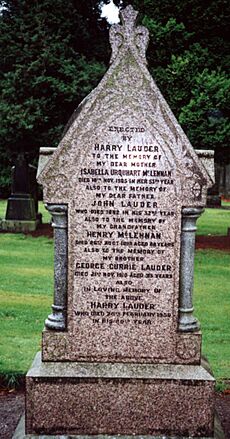
Harry Lauder spent his last years at his home, Lauder Ha', in Strathaven. He died on February 26, 1950, at 79 years old. His funeral was a big event, reported by newsreels. The Duke of Hamilton, a close family friend, led the funeral procession. Wreaths were sent from Queen Elizabeth and Sir Winston Churchill. Harry Lauder was buried with his brother and mother in the family plot at Bent Cemetery in Hamilton.
In 1932, he put the land for Lauder Hall in his niece Margaret's name. This was a smart move to avoid high taxes after his death, as he wanted the property to stay in the family and become a museum. He left a large amount of money, but a significant portion went to taxes. After giving money to his family, the rest went to Margaret.
Remembering Sir Harry Lauder
Harry Lauder's influence continued after his death. In the 1941 film "Babes on Broadway", Mickey Rooney imitated Lauder and sang "She Is Ma Daisy." In the 1942 film Random Harvest, Greer Garson also sang "She Is Ma Daisy" while doing an impression of him.
Many websites now feature his work. The Harry Lauder Collection, gathered by entertainer Jimmy Logan, was bought for the nation and given to the University of Glasgow. A road in Portobello, Scotland, is named the Sir Harry Lauder Road in his honor.
In 1987, the Lord Provost of Edinburgh held a special lunch to celebrate 60 years since Lauder received the "Freedom of the City." In 2001, the Sir Harry Lauder Memorial Garden was opened in Portobello. The BBC also broadcast a documentary about him in 2005.
In the 1990s, parts of Harry Lauder's recordings were used in songs by the Scottish musician Martyn Bennett. The "Corkscrew hazel" plant, known for its twisted branches, is sometimes called "Harry Lauder's Walking Stick" because of the crooked stick he often carried.
Selected Films
- Huntingtower (1927)
- Auld Lang Syne (1929)
- The End of the Road (1936)


